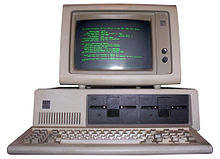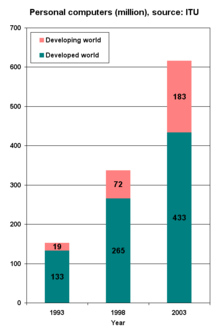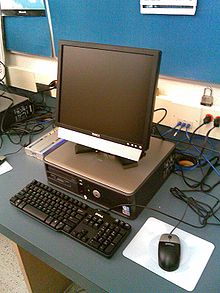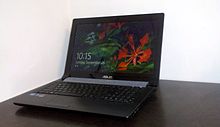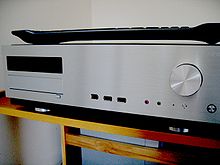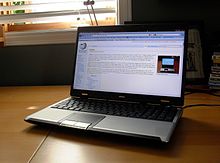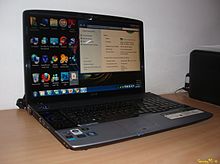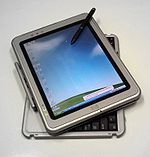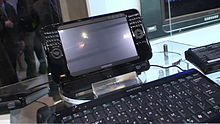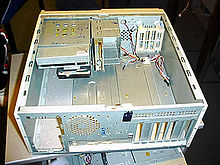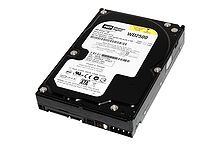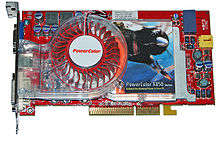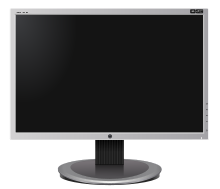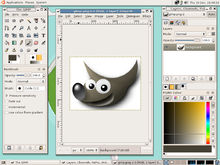- Personal computer
-
This article is about personal computers in general. For computers generally referred to as "PCs", see IBM PC compatible. For hardware components dealing with personal computers, see Personal computer hardware.
Personal computer 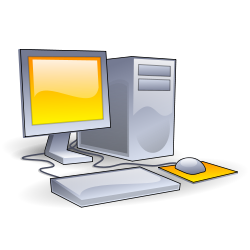
An illustration of a modern personal desktop computerA personal computer (PC) is any general-purpose computer whose size, capabilities, and original sales price make it useful for individuals, and which is intended to be operated directly by an end-user with no intervening computer operator. In contrast, the batch processing or time-sharing models allowed large expensive mainframe systems to be used by many people, usually at the same time. Large data processing systems require a full-time staff to operate efficiently.
Software applications for personal computers include, but are not limited to, word processing, spreadsheets, databases, Web browsers and e-mail clients, digital media playback, games, and myriad personal productivity and special-purpose software applications. Modern personal computers often have connections to the Internet, allowing access to the World Wide Web and a wide range of other resources. Personal computers may be connected to a local area network (LAN), either by a cable or a wireless connection. A personal computer may be a desktop computer or a laptop, tablet PC, or a handheld PC.
While early PC owners usually had to write their own programs to do anything useful with the machines, today's users have access to a wide range of commercial software and free software, which is provided in ready-to-run or ready-to-compile form. Since the early 1990s, Microsoft and Intel have dominated much of the personal computer market, first with MS-DOS and then with the Wintel platform. Alternatives to Windows include Apple's Mac OS X and the open-source Linux OSes. AMD is the major alternative to Intel. Applications and games for PCs are typically developed and distributed independently from the hardware or OS manufacturers, whereas software for many mobile phones and other portable systems is approved and distributed through a centralized online store.[1][2]
In July and August 2011, marketing businesses and journalists began to talk about the 'Post-PC Era', in which the desktop form factor was being replaced with more portable computing such as netbooks, Tablet PCs, and smartphones.[3]
Contents
History
Main article: History of personal computersSee also: Microcomputer revolutionIn what was later to be called The Mother of All Demos, SRI researcher Douglas Engelbart in 1968 gave a preview of what would become the staples of daily working life in the 21st century - e-mail, hypertext, word processing, video conferencing, and the mouse. The demonstration required technical support staff and a mainframe time-sharing computer that were far too costly for individual business use at the time.
By the early 1970s, people in academic or research institutions had the opportunity for single-person use of a computer system in interactive mode for extended durations, although these systems would still have been too expensive to be owned by a single person.
In the 1970s Hewlett Packard introduced fully BASIC programmable computers that fit entirely on top of a desk, including a keyboard, a small one-line display and printer. The Xerox Alto, developed in 1973 at Xerox's Palo Alto Research Center (PARC), had a graphical operating system (GUI) that later served as inspiration for Apple Computer's Macintosh, and Microsoft's Windows operating system. The Wang 2200 of 1973 had a full-size cathode ray tube (CRT) and cassette tape storage. The IBM 5100 in 1975 had a small CRT display and could be programmed in BASIC and APL. These were generally expensive specialized computers sold for business or scientific uses. The introduction of the microprocessor, a single chip with all the circuitry that formerly occupied large cabinets, led to the proliferation of personal computers after 1975.
Early personal computers — generally called microcomputers — were sold often in kit form and in limited volumes, and were of interest mostly to hobbyists and technicians. Minimal programming was done with toggle switches to enter instructions, and output was provided by front panel lamps. Practical use required adding peripherals such as keyboards, computer displays, disk drives, and printers. Micral N was the earliest commercial, non-kit microcomputer based on a microprocessor, the Intel 8008. It was built starting in 1972 and about 90,000 units were sold. In 1976 Steve Jobs and Steve Wozniak sold the Apple I computer circuit board, which was fully prepared and contained about 30 chips. The first successfully mass marketed personal computer was the Commodore PET introduced in January 1977. It was soon followed by the Apple II (usually referred to as the "Apple ][") in June 1977, and the TRS-80 from Radio Shack in November 1977. Mass-market ready-assembled computers allowed a wider range of people to use computers, focusing more on software applications and less on development of the processor hardware.
Through the late 1970s and into the 1980s, computers were further developed for household use, with software for personal productivity, programming and games. One such machine, the Commodore 64, totaled 17 million units sold, making it the best-selling single personal computer model of all time.[4] Somewhat larger and more expensive systems (although still low-cost compared with minicomputers and mainframes) were aimed at office and small business use. Workstations are characterized by high-performance processors and graphics displays, with large local disk storage, networking capability, and running under a multitasking operating system.
Eventually, due to the influence of the IBM PC on the personal computer market, personal computers and home computers lost any technical distinction. Business computers acquired color graphics capability and sound, and home computers and game systems users used the same processors and operating systems as office workers. Mass-market computers had graphics capabilities and memory comparable to dedicated workstations of a few years before. Even local area networking, originally a way to allow business computers to share expensive mass storage and peripherals, became a standard feature of personal computers used at home.
In 1982 "The Computer" was named Machine of the Year by Time Magazine.
Market and sales
See also: Market share of leading PC vendorsIn 2001, 125 million personal computers were shipped in comparison to 48 thousand in 1977. More than 500 million personal computers were in use in 2002 and one billion personal computers had been sold worldwide from the mid-1970s up to this time. Of the latter figure, 75 percent were professional or work related, while the rest were sold for personal or home use. About 81.5 percent of personal computers shipped had been desktop computers, 16.4 percent laptops and 2.1 percent servers. The United States had received 38.8 percent (394 million) of the computers shipped, Europe 25 percent and 11.7 percent had gone to the Asia-Pacific region, the fastest-growing market as of 2002. The second billion was expected to be sold by 2008.[5] Almost half of all the households in Western Europe had a personal computer and a computer could be found in 40 percent of homes in United Kingdom, compared with only 13 percent in 1985.[6]
The global personal computer shipments were 350.9 million units in 2010[7], 308.3 million units in 2009[8] and 302.2 million units in 2008.[9][10] The shipments were 264 million units in the year 2007, according to iSuppli,[11] up 11.2 percent from 239 million in 2006.[12] In 2004, the global shipments were 183 million units, an 11.6 percent increase over 2003.[13] In 2003, 152.6 million computers were shipped, at an estimated value of $175 billion.[14] In 2002, 136.7 million PCs were shipped, at an estimated value of $175 billion.[14] In 2000, 140.2 million personal computers were shipped, at an estimated value of $226 billion.[14] Worldwide shipments of personal computers surpassed the 100-million mark in 1999, growing to 113.5 million units from 93.3 million units in 1998.[15] In 1999, Asia had 14.1 million units shipped.[16]
For 2011, global PC shipments are expected to reach 364 million units, a 3.8% growth comparing to 2010[17].
As of June 2008, the number of personal computers in use worldwide hit one billion, while another billion is expected to be reached by 2014. Mature markets like the United States, Western Europe and Japan accounted for 58 percent of the worldwide installed PCs. The emerging markets were expected to double their installed PCs by 2012 and to take 70 percent of the second billion PCs. About 180 million computers (16 percent of the existing installed base) were expected to be replaced and 35 million to be dumped into landfill in 2008. The whole installed base grew 12 percent annually.[18][19]
Based on IDC data for Q2 2011, for the first time China surpassed US in PC shipments by 18.5 million and 17.7 million respectively. It is reflects the rising of emerging markets as well as the relative stagnation of mature regions.[20]
In the developed world, there has been a vendor tradition to keep adding functions to maintain high prices of personal computers. However, since the introduction of the One Laptop per Child foundation and its low-cost XO-1 laptop, the computing industry started to pursue the price too. Although introduced only one year earlier, there were 14 million netbooks sold in 2008.[21] Besides the regular computer manufacturers, companies making especially rugged versions of computers have sprung up, offering alternatives for people operating their machines in extreme weather or environments.[22]
Deloitte consulting firm predicts that in 2011 smartphones and tablet computers as computing devices will surpass the PCs sales. Pc era is far from over as PCs will remain the main computing platform.[23]
Average selling price
Selling prices of personal computers, unlike other consumer commodities, steadily declined due to lower costs of production and manufacture. Capabilities of the computers also increased. In 1975, an Altair kit sold for only around US $400, but required customers to solder components into circuit boards; peripherals required to interact with the system in alphanumeric form instead of blinking lights would add another $2000, and the resultant system was only of use to hobbyists.[24]
At their introduction in 1981, the US $1,795 price of the Osborne 1 and its competitor Kaypro was considered an attractive price point; these systems had text-only displays and only floppy disks for storage. By 1982, Michael Dell observed that a personal computer system selling at retail for about $3,000 US was made of components that cost the dealer about $600; typical gross margin on a computer unit was around $1,000.[25] The total value of personal computer purchases in the US in 1983 was about $4 billion, comparable to total sales of pet food. By late 1998, the average selling price of personal computer systems in the United States had dropped below $1000.[26]
For Microsoft Windows systems, the average selling price (ASP) showed a decline in 2008/2009, possibly due to low-cost netbooks, drawing $569 for desktop computers and $689 for laptops at U.S. retail in August 2008. In 2009, ASP had further fallen to $533 for desktops and to $602 for notebooks by January and to $540 and $560 in February.[27] According to research firm NPD, the average selling price of all Windows portable PCs has fallen from $659 in October 2008 to $519 in October 2009.[28]
Types
Stationary
Workstation
 Sun SPARCstation 1+, 25 MHz RISC processor from early 1990s
Sun SPARCstation 1+, 25 MHz RISC processor from early 1990s Main article: Workstation
Main article: WorkstationA workstation is a high-end personal computer designed for technical or scientific applications. Intended primarily to be used by one person at a time, they are commonly connected to a local area network and run multi-user operating systems. Workstations are used for tasks such as computer-aided design, drafting and modeling, computation-intensive scientific and engineering calculations, image processing, architectural modeling, and computer graphics for animation and motion picture visual effects.[29]
Desktop computer
Main article: Desktop computer
Prior to the wide spread of PCs a computer that could fit on a desk was considered remarkably small. Today the phrase usually indicates a particular style of computer case. Desktop computers come in a variety of styles ranging from large vertical tower cases to small form factor models that can be tucked behind an LCD monitor. In this sense, the term 'desktop' refers specifically to a horizontally oriented case, usually intended to have the display screen placed on top to save space on the desk top. Most modern desktop computers have separate screens and keyboards.Gaming Computer
Main article: Gaming computerGames have been on computers since 1962 when Spacewar! was released. Today Personal Computer Gaming or PC gaming is a very popular pastime. Gaming computers tend to also be about the looks of the case rather than just the specifications of the hardware. A gaming computer needs to be much more powerful than a PC that someone is using to do office work and to surf the internet. A Gaming Computer has to have a good graphics card so that it can process all the 3D models and shapes that are on the screen. In addition the Central processing unit or CPU has to do more work to calculate game mechanics, figure out gravity, and assist with the graphics and process the sound. Most serious gamers prefer to build their own computer or rig. This is because they can get exactly what they want and the price is a lot cheaper. When building a ‘high end’ computer the price is generally over $1000 with the motherboard costing from $300-$800 and the processor costing around $400-$500 and graphics cards that can cost more than $600. Many people say this is expensive but it's comparable to a video game console such as an Xbox 360 or a PlayStation 3 as proced when released. In addition, a computer can be used for much more than just gaming, and a $1000 computer will last at least 5 years. The choice of parts to build a computer are vast as many companies build different parts of the system.
Single unit
Further information: All-in-one computerSingle unit PCs (also known as all-in-one PCs) are a subtype of desktop computers, which combine the monitor and case of the computer within a single unit. The monitor often utilizes a touchscreen as an optional method of user input, however detached keyboards and mice are normally still included. The inner components of the PC are often located directly behind the monitor, and many are built similarly to laptops.
Nettop
Main article: NettopA subtype of desktops, called nettops, was introduced by Intel in February 2008 to describe low-cost, lean-function, desktop computers. A similar subtype of laptops (or notebooks) are the netbooks (see below). The product line features the new Intel Atom processor which specially enables them to consume less power and to be built into small enclosures.
Home theater PC
Main article: Home theater PCA home theater PC (HTPC) is a convergence device that combines the functions of a personal computer and a digital video recorder. It is connected to a television or a television-sized computer display and is often used as a digital photo, music, video player, TV receiver and digital video recorder. Home theater PCs are also referred to as media center systems or media servers. The general goal in a HTPC is usually to combine many or all components of a home theater setup into one box. They can be purchased pre-configured with the required hardware and software needed to add television programming to the PC, or can be cobbled together out of discrete components as is commonly done with MythTV, Windows Media Center, GB-PVR, SageTV, Famulent or LinuxMCE.
Mobile
Laptop
Main article: LaptopA laptop computer or simply laptop, also called a notebook computer, is a small personal computer designed for portability. Usually all of the interface hardware needed to operate the laptop, such as USB ports (previously parallel and serial ports), graphics card, sound channel, etc., are built in to a single unit. Laptops contain high capacity batteries that can power the device for extensive periods of time, enhancing portability. Once the battery charge is depleted, it will have to be recharged through a power outlet. In the interest of saving power, weight and space, they usually share RAM with the video channel, slowing their performance compared to an equivalent desktop machine.
One main drawback of the laptop is sometimes, due to the size and configuration of components, relatively little can be done to upgrade the overall computer from its original design. Internal upgrades are either not manufacturer recommended, can damage the laptop if done with poor care or knowledge, or in some cases impossible, making the desktop PC more modular. Some internal upgrades, such as memory and hard disks upgrades are often easy, a display or keyboard upgrade is usually impossible. The laptop has the same access as the desktop to the wide variety of devices, such as external displays, mice, cameras, storage devices and keyboards, which may be attached externally through USB ports and other less common ports such as external video.
A subtype of notebooks, called subnotebooks, are computers with most of the features of a standard laptop computer but smaller. They are larger than hand-held computers, and usually run full versions of desktop/laptop operating systems. Ultra-Mobile PCs (UMPC) are usually considered subnotebooks, or more specifically, subnotebook Tablet PCs (see below). Netbooks are sometimes considered in this category, though they are sometimes separated in a category of their own (see below).
Desktop replacement
Main article: Desktop replacement computerA desktop replacement computer (DTR) is a personal computer that provides the full capabilities of a desktop computer while remaining mobile. They are often larger, bulkier laptops. Because of their increased size, this class of computer usually includes more powerful components and a larger display than generally used in smaller portable computers and can have a relatively limited battery capacity (or none at all). Some use a limited range of desktop components to provide better performance at the expense of battery life. These are sometimes called desknotes, a portmanteau of the words "desktop" and "notebook," though the term is also applied to desktop replacement computers in general.[30]
Netbook
Main article: Netbook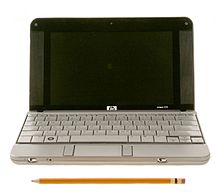 An HP netbook
An HP netbook
Netbooks (also called mini notebooks or subnotebooks) are a rapidly evolving[31] category of small, light and inexpensive laptop computers suited for general computing and accessing web-based applications; they are often marketed as "companion devices," that is, to augment a user's other computer access.[31] Walt Mossberg called them a "relatively new category of small, light, minimalist and cheap laptops." [32] By August 2009, CNET called netbooks "nothing more than smaller, cheaper notebooks."[31].
Initially, their primary defining characteristic was the lack of an optical disc drive, requiring it to be a separate and external device. This has become less important as flash memory devices have gradually increased in capacity, replacing the writable optical disc (e.g. CD-RW, DVD-RW) as a transportable storage medium.
At their inception in late 2007 — as smaller notebooks optimized for low weight and low cost[33] — netbooks omitted key features (e.g., the optical drive), featured smaller screens and keyboards, and offered reduced specification and computing power. Over the course of their evolution, netbooks have ranged in size from below 5 in[34] to over 13 in,[35] and from ~1 kg (2-3 pounds). Often significantly less expensive than other laptops,[36] by mid-2009, netbooks had been offered to users "free of charge", with an extended service contract purchase of a cellular data plan.[37]
In the short period since their appearance, netbooks have grown in size and features, now converging with new smaller, lighter notebooks. By mid 2009, CNET noted "the specs are so similar that the average shopper would likely be confused as to why one is better than the other," noting "the only conclusion is that there really is no distinction between the devices."[31]
Tablet PC
Main article: Tablet personal computerA tablet PC is a notebook or slate-shaped mobile computer. Its touchscreen or graphics tablet/screen hybrid technology allows the user to operate the computer with a stylus or digital pen, or a fingertip, instead of a keyboard or mouse. The form factor offers a more mobile way to interact with a computer. Tablet PCs are often used where normal notebooks are impractical or unwieldy, or do not provide the needed functionality.
Ultra-mobile PC
Main article: Ultra-mobile PCThe ultra-mobile PC (UMPC) is a specification for a small form factor of tablet PCs. It was developed as a joint development exercise by Microsoft, Intel, and Samsung, among others. Current UMPCs typically feature the Windows XP, Windows Vista, Windows 7, or Linux operating system and low-voltage Intel Atom or VIA C7-M processors.
Pocket PC
Main article: Pocket PC An O2 pocket PC
An O2 pocket PC
A pocket PC is a hardware specification for a handheld-sized computer (personal digital assistant) that runs the Microsoft Windows Mobile operating system. It may have the capability to run an alternative operating system like NetBSD or Linux. It has many of the capabilities of modern desktop PCs.
Currently there are tens of thousands of applications for handhelds adhering to the Microsoft Pocket PC specification, many of which are freeware. Some of these devices also include mobile phone features and thus actually represent a smartphone. Microsoft compliant Pocket PCs can also be used with many other add-ons like GPS receivers, barcode readers, RFID readers, and cameras. In 2007, with the release of Windows Mobile 6, Microsoft dropped the name Pocket PC in favor of a new naming scheme. Devices without an integrated phone are called Windows Mobile Classic instead of Pocket PC. Devices with an integrated phone and a touch screen are called Windows Mobile Professional.[38]
Hardware
 An exploded view of a modern personal computer and peripherals:
An exploded view of a modern personal computer and peripherals:
- Scanner
- CPU (Microprocessor)
- Primary storage (RAM)
- Expansion cards (graphics cards, etc.)
- Power supply
- Optical disc drive
- Secondary storage (Hard disk)
- Motherboard
- Speakers
- Monitor
- System software
- Application software
- Keyboard
- Mouse
- External hard disk
- Printer
Main article: Personal computer hardwareMass-market consumer computers use highly standardized components and so are simple for an end user to assemble into a working system. A typical desktop computer consists of a computer case which holds the power supply, motherboard, hard disk and often an optical disc drive. External devices such as a computer monitor or visual display unit, keyboard, and a pointing device are usually found in a personal computer.
The motherboard connects all processor, memory and peripheral devices together. The RAM, graphics card and processor are mounted directly onto the motherboard. The central processing unit microprocessor chip plugs into a socket. Expansion memory plugs into memory sockets. Some motherboards have the video display adapter, sound and other peripherals integrated onto the motherboard. Others use expansion slots for graphics cards, network cards, or other I/O devices. Disk drives for mass storage are connected to the mother board with a cable, and to the power supply through another cable. Usually disk drives are mounted in the same case as the motherboard; formerly, expansion chassis were made for additional disk storage.
The graphics and sound card can have a break out box to keep the analog parts away from the electromagnetic radiation inside the computer case. For really large amounts of data, a tape drive can be used or (extra) hard disks can be put together in an external case.
The keyboard and the mouse are external devices plugged into the computer through connectors on an I/O panel on the back of the computer. The monitor is also connected to the I/O panel, either through an onboard port on the motherboard, or a port on the graphics card.
The hardware capabilities of personal computers can sometimes be extended by the addition of expansion cards connected via an expansion bus. Some standard peripheral buses often used for adding expansion cards in personal computers as of 2005 are PCI, AGP (a high-speed PCI bus dedicated to graphics adapters), and PCI Express. Most personal computers as of 2005 have multiple physical PCI expansion slots. Many also include an AGP bus and expansion slot or a PCI Express bus and one or more expansion slots, but few PCs contain both buses.
Toxic chemicals, such as lead and mercury, are found in certain pieces of PC hardware. Lead is found in the Cathode ray tube (CRT), which is located inside the monitor, as well as in the Printed circuit board. While daily PC users are not exposed to these toxic elements, danger arises in computer recycling, and thus stems the controversy of electronic waste (e-Waste). The process of computer recycling involves workers responsible for manually breaking down computers, which leads to inevitable exposure to these toxic chemicals and serious health issues. Lead is known to cause damage to the central nervous system, kidneys, and slow down child brain development. Mercury, another toxic element found in PCs, is located in the screen's fluorescent lamp, laser light generators in the optical disk drive, and in mercury batteries in the circuit board and expansion cards. Even the smallest amount of mercury, if it is inhaled or digested can cause serious brain damage. Other chemicals found in PCs are cadmium, chromium, Polyvinyl chloride (PVC), and barium, which are also found in the motherboard and other crucial pieces of the computer. In each individual computer, about 17% of the computer is lead, copper, zinc, mercury, and cadmium, 23% is plastic (which usually gets burned and causes extreme air pollution), and 14% is Aluminium and 20% is Iron (the last two do not cause extreme health risks, however they are natural elements and do not decompose, which means they continue to take up space unless they are recycled into new computers). Although there is not a huge amount of these hazardous chemicals in each individual computer, even the smallest amount of lead or mercury can ruin a community’s drinking water, or cause serious brain damage.
Computer case
Main article: Computer caseA stripped ATX case lying on its side.
A computer case is the enclosure that contains the main components of a computer. Cases are usually constructed from steel or aluminum, although other materials such as wood and plastic have been used. Cases can come in many different sizes, or form factors. The size and shape of a computer case is usually determined by the form factor of the motherboard that it is designed to accommodate, since this is the largest and most central component of most computers. Consequently, personal computer form factors typically specify only the internal dimensions and layout of the case. Form factors for rack-mounted and blade servers may include precise external dimensions as well, since these cases must themselves fit in specific enclosures.
Currently, the most popular form factor for desktop computers is ATX, although microATX and small form factors have become very popular for a variety of uses. Companies like Shuttle Inc. and AOpen have popularized small cases, for which FlexATX is the most common motherboard size.
Power supply unit
Main article: Power supply unit (computer)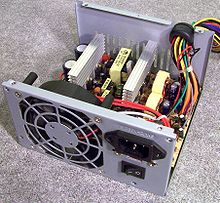 Computer power supply unit with top cover removed.
Computer power supply unit with top cover removed.
The power supply unit converts general purpose electric current from the mains to direct current for the other components of the computer.
Processor
Main article: Central processing unitThe central processing unit, or CPU, is that part of a computer which executes software program instructions. In older computers this circuitry was formerly on several printed circuit boards, but in PCs is a single integrated circuit. Nearly all PCs contain a type of CPU known as a microprocessor. The microprocessor often plugs into the motherboard using one of many different types of sockets. IBM PC compatible computers use an x86-compatible processor, usually made by Intel, AMD, VIA Technologies or Transmeta. Apple Macintosh computers were initially built with the Motorola 680x0 family of processors, then switched to the PowerPC series (a RISC architecture jointly developed by Apple Computer, IBM and Motorola), but as of 2006, Apple switched again, this time to x86-compatible processors by Intel. Modern CPUs are equipped with a fan attached via heat sink.
Motherboard
Main article: MotherboardThe motherboard, also referred to as systemboard or mainboard, is the primary circuit board within a personal computer. Many other components connect directly or indirectly to the motherboard. Motherboards usually contain one or more CPUs, supporting circuitry - usually integrated circuits (ICs) - providing the interface between the CPU memory and input/output peripheral circuits, main memory, and facilities for initial setup of the computer immediately after power-on (often called boot firmware or, in IBM PC compatible computers, a BIOS). In many portable and embedded personal computers, the motherboard houses nearly all of the PC's core components. Often a motherboard will also contain one or more peripheral buses and physical connectors for expansion purposes. Sometimes a secondary daughter board is connected to the motherboard to provide further expandability or to satisfy space constraints.
Main memory
Main article: Primary storage 1GB DDR SDRAM PC-3200 module
1GB DDR SDRAM PC-3200 module
A PC's main memory is fast storage that is directly accessible by the CPU, and is used to store the currently executing program and immediately needed data. PCs use semiconductor random access memory (RAM) of various kinds such as DRAM, SDRAM or SRAM as their primary storage. Which exact kind depends on cost/performance issues at any particular time. Main memory is much faster than mass storage devices like hard disks or optical discs, but is usually volatile, meaning it does not retain its contents (instructions or data) in the absence of power, and is much more expensive for a given capacity than is most mass storage. Main memory is generally not suitable for long-term or archival data storage.
Hard disk
Main article: Hard disk driveMass storage devices store programs and data even when the power is off; they do require power to perform read and write functions during usage. Although flash memory has dropped in cost, the prevailing form of mass storage in personal computers is still the hard disk. The disk drives use a sealed head/disk assembly (HDA) which was first introduced by IBM's "Winchester" disk system. The use of a sealed assembly allowed the use of positive air pressure to drive out particles from the surface of the disk, which improves reliability.
If the mass storage controller provides for expandability, a PC may also be upgraded by the addition of extra hard disk or optical disc drives. For example, BD-ROMs, DVD-RWs, and various optical disc recorders may all be added by the user to certain PCs. Standard internal storage device connection interfaces are PATA, Serial ATA, SCSI
Video card
Main article: Video cardThe video card - otherwise called a graphics card, graphics adapter or video adapter - processes and renders the graphics output from the computer to the computer display, and is an essential part of the modern computer. On older models, and today on budget models, graphics circuitry tended to be integrated with the motherboard but, for modern flexible machines, they are supplied in PCI, AGP, or PCI Express format.
When the IBM PC was introduced, most existing business-oriented personal computers used text-only display adapters and had no graphics capability. Home computers at that time had graphics compatible with television signals, but with low resolution by modern standards owing to the limited memory available to the eight-bit processors available at the time.
Visual display unit
Main article: Visual display unitA visual display unit (or monitor) is a piece of electrical equipment, usually separate from the computer case, which displays viewable images generated by a computer without producing a permanent record. The word "monitor" is used in other contexts; in particular in television broadcasting, where a television picture is displayed to a high standard on a broadcast reference monitor. A computer display device is usually either a cathode ray tube or some form of flat panel such as a TFT LCD. The monitor comprises the display device, circuitry to generate a picture from electronic signals sent by the computer, and an enclosure or case. Within the computer, either as an integral part or a plugged-in Expansion card, there is circuitry to convert internal data to a format compatible with a monitor. The images from monitors originally contained only text, but as Graphical user interfaces emerged and became common, they began to display more images and multimedia content.
Keyboard
Main article: Keyboard (computing)In computing, a keyboard is an arrangement of buttons that each correspond to a function, letter, or number. They are the primary devices of inputting text. In most cases, they contain an array of keys specifically organized with the corresponding letters, numbers, and functions printed or engraved on the button. They are generally designed around an operators language, and many different versions for different languages exist. In English, the most common layout is the QWERTY layout, which was originally used in typewriters. They have evolved over time, and have been modified for use in computers with the addition of function keys, number keys, arrow keys, and OS specific keys. Often, specific functions can be achieved by pressing multiple keys at once or in succession, such as inputting characters with accents or opening a task manager. Programs use keyboard shortcuts very differently and all use different keyboard shortcuts for different program specific operations, such as refreshing a web page in a web browser or selecting all text in a word processor.
Mouse
Main article: Mouse (computing)A Mouse on a computer is a small, slideable device that users hold and slide around to point at, click on, and sometimes drag objects on screen in a graphical user interface using a pointer on screen. Almost all Personal Computers have mice. It may be plugged into a computer's rear mouse socket, or as a USB device, or, more recently, may be connected wirelessly via a USB antenna or Bluetooth antenna. In the past, they had a single button that users could press down on the device to "click" on whatever the pointer on the screen was hovering over. Now, however, many Mice have two or three buttons(possibly more); a "right click" function button on the mouse, which performs a secondary action on a selected object, and a scroll wheel, which users can rotate using their fingers to "scroll" up or down. The scroll wheel can also be pressed down, and therefore be used as a third button. Some mouse wheels may be tilted from side to side to allow sideways scrolling. Different programs make use of these functions differently, and may scroll horizontally by default with the scroll wheel, open different menus with different buttons, among others. These functions may be user defined through software utilities.
Mice traditionally detected movement and communicated with the computer with an internal "mouse ball"; and used optical encoders to detect rotation of the ball and tell the computer where the mouse has moved. However, these systems were subject to low durability, accuracy and required internal cleaning. Modern mice use optical technology to directly trace movement of the surface under the mouse and are much more accurate, durable and almost maintenance free. They work on a wider variety of surfaces and can even operate on walls, ceilings or other non-horizontal surfaces.
Other components
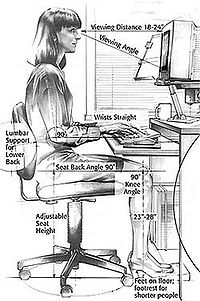 Proper ergonomic design of personal computer workplace is necessary to prevent repetitive strain injuries, which can develop over time and can lead to long-term disability.[39]
Proper ergonomic design of personal computer workplace is necessary to prevent repetitive strain injuries, which can develop over time and can lead to long-term disability.[39]
- Mass storage
All computers require either fixed or removable storage for their operating system, programs and user generated material.
Formerly the 5¼ inch and 3½ inch floppy drive were the principal forms of removable storage for backup of user files and distribution of software.As memory sizes increased, the capacity of the floppy did not keep pace; the Zip drive and other higher-capacity removable media were introduced but never became as prevalent as the floppy drive.
By the late 1990s the optical drive, in CD and later DVD and Blu-ray Disc, became the main method for software distribution, and writeable media provided backup and file interchange. Floppy drives have become uncommon in desktop personal computers since about 2000, and were dropped from many laptop systems even earlier.[note 1]
Early home computers used compact audio cassettes for file storage; these were at the time a very low cost storage solution, but were displaced by floppy disk drives when manufacturing costs dropped, by the mid 1980s.
A second generation of tape recorders was provided when Videocassette recorders were pressed into service as backup media for larger disk drives. All these systems were less reliable and slower than purpose-built magnetic tape drives. Such tape drives were uncommon in consumer-type personal computers but were a necessity in business or industrial use.
Interchange of data such as photographs from digital cameras is greatly expedited by installation of a card reader, which often is compatible with several forms of flash memory. It is usually faster and more convenient to move large amounts of data by removing the card from the mobile device, instead of communicating with the mobile device through a USB interface.
A USB flash drive today performs much of the data transfer and backup functions formerly done with floppy drives, Zip disks and other devices. Main-stream current operating systems for personal computers provide standard support for flash drives, allowing interchange even between computers using different processors and operating systems. The compact size and lack of moving parts or dirt-sensitive media, combined with low cost for high capacity, have made flash drives a popular and useful accessory for any personal computer user.
The operating system (e.g.: Microsoft Windows, Mac OS, Linux or many others) can be located on any storage, but typically it is on a hard disks. A Live CD is the running of a OS directly from a CD. While this is slow compared to storing the OS on a hard drive, it is typically used for installation of operating systems, demonstrations, system recovery, or other special purposes. Large flash memory is currently more expensive than hard drives of similar size (as of mid-2008) but are starting to appear in laptop computers because of their low weight, small size and low power requirements.
- Computer communications
- Common peripherals and adapter cards
- Headset
- Joystick
- Microphone
- Printer
- Scanner
- Sound adapter card as a separate card rather than located on the motherboard
- Speakers
- Webcam
Software
Main article: Computer softwareComputer software is a general term used to describe a collection of computer programs, procedures and documentation that perform some tasks on a computer system.[40] The term includes application software such as word processors which perform productive tasks for users, system software such as operating systems, which interface with hardware to provide the necessary services for application software, and middleware which controls and co-ordinates distributed systems.
Software applications for word processing, Internet browsing, Internet faxing, e-mail and other digital messaging, multimedia playback, computer game play and computer programming are common. The user of a modern personal computer may have significant knowledge of the operating environment and application programs, but is not necessarily interested in programming nor even able to write programs for the computer. Therefore, most software written primarily for personal computers tends to be designed with simplicity of use, or "user-friendliness" in mind. However, the software industry continuously provide a wide range of new products for use in personal computers, targeted at both the expert and the non-expert user.
Operating system
Main article: Operating systemSee also: Usage share of operating systemsAn operating system (OS) manages computer resources and provides programmers with an interface used to access those resources. An operating system processes system data and user input, and responds by allocating and managing tasks and internal system resources as a service to users and programs of the system. An operating system performs basic tasks such as controlling and allocating memory, prioritizing system requests, controlling input and output devices, facilitating computer networking and managing files.
Common contemporary desktop OSs are Microsoft Windows, Mac OS X, Linux, Solaris and FreeBSD. Windows, Mac, and Linux all have server and personal variants. With the exception of Microsoft Windows, the designs of each of the aforementioned OSs were inspired by, or directly inherited from, the Unix operating system. Unix was developed at Bell Labs beginning in the late 1960s and spawned the development of numerous free and proprietary operating systems.
Microsoft Windows
Main article: Microsoft WindowsMicrosoft Windows is the collective brand name of several software operating systems by Microsoft. Microsoft first introduced an operating environment named Windows in November 1985 as an add-on to MS-DOS in response to the growing interest in graphical user interfaces (GUIs)[41][42] generated by Apple's 1984 introduction of the Macintosh. The most recent client version of Windows is Windows 7 and Windows Server 2008 R2 which was available at retail on October 22, 2009.
Mac OS X
Main article: Mac OS XMac OS X is a line of operating systems developed, marketed, and sold by Apple Inc.. Mac OS X is the successor to the original Mac OS, which had been Apple's primary operating system since 1984. Mac OS X is a Unix-based graphical operating system. The most recent version of Mac OS X is Mac OS X Lion.
AmigaOS
Main article: AmigaOSAmigaOS is the default native operating system of the Amiga personal computer. It was developed first by Commodore International, and initially introduced in 1985 with the Amiga 1000. Early versions (1.0-3.9) run on the Motorola 68k series of 16-bit and 32-bit microprocessors, while the newer AmigaOS 4 runs only on PowerPC microprocessors. On top of a preemptive multitasking kernel called Exec, it includes an abstraction of the Amiga's unique hardware, a disk operating system called AmigaDOS, a windowing system API called Intuition and a graphical user interface called Workbench. A command line interface called AmigaShell is also available and integrated into the system. The GUI and the CLI complement each other and share the same privileges. The current holder of the Amiga intellectual properties is Amiga Inc. They oversaw the development of AmigaOS 4 but did not develop it themselves, contracting it instead to Hyperion Entertainment. On 20 December 2006, Amiga Inc terminated Hyperion's license to continue development of AmigaOS 4. However, in 30 September 2009, Hyperion was granted an exclusive, perpetual, worldwide right to AmigaOS 3.1 in order to use, develop, modify, commercialize, distribute and market AmigaOS 4.x and subsequent versions of AmigaOS (including AmigaOS 5).
Linux
Main article: Linux A Linux distribution running KDE Plasma Desktop.
A Linux distribution running KDE Plasma Desktop.
Linux is a family of Unix-like computer operating systems. Linux is one of the most prominent examples of free software and open source development: typically all underlying source code can be freely modified, used, and redistributed by anyone.[43] The name "Linux" comes from the Linux kernel, started in 1991 by Linus Torvalds. The system's utilities and libraries usually come from the GNU operating system, announced in 1983 by Richard Stallman. The GNU contribution is the basis for the alternative name GNU/Linux.[44]
Known for its use in servers as part of the LAMP application stack, Linux is supported by corporations such as Dell, Hewlett-Packard, IBM, Novell, Oracle Corporation, Red Hat, Canonical Ltd. and Sun Microsystems. It is used as an operating system for a wide variety of computer hardware, including desktop computers, netbooks, supercomputers,[45] video game systems, such as the PlayStation 3, several arcade games, and embedded devices such as mobile phones, portable media players, routers, and stage lighting systems.
Applications
Main article: Application softwareA computer user will apply application software to carry out a specific task. System software supports applications and provides common services such as memory management, network connectivity, or device drivers; all of which may be used by applications but which are not directly of interest to the end user. A simple, if imperfect analogy in the world of hardware would be the relationship of an electric light bulb (an application) to an electric power generation plant (a system). The power plant merely generates electricity, not itself of any real use until harnessed to an application like the electric light that performs a service that benefits the user.
Typical examples of software applications are word processors, spreadsheets, and media players. Multiple applications bundled together as a package are sometimes referred to as an application suite. Microsoft Office and OpenOffice.org, which bundle together a word processor, a spreadsheet, and several other discrete applications, are typical examples. The separate applications in a suite usually have a user interface that has some commonality making it easier for the user to learn and use each application. And often they may have some capability to interact with each other in ways beneficial to the user. For example, a spreadsheet might be able to be embedded in a word processor document even though it had been created in the separate spreadsheet application.
End-user development tailors systems to meet the user's specific needs. User-written software include spreadsheet templates, word processor macros, scientific simulations, graphics and animation scripts. Even email filters are a kind of user software. Users create this software themselves and often overlook how important it is.
Disposal of
Personal Computers are recycled in different methods, but they can also become a large contributor to the 50 million tons of waste of discarded electronic goods that is being generated annually, according to the United Nations Environment Programme. In order to solve the issue of electronic waste affecting developing countries and the environment, an Extended producer responsibility act was implemented. Organizations, such as, the Silicon Valley Toxics Coalition, Basel Action Network, Toxics Link India, SCOPE, and Greenpeace contribute to the strategy. The Silicon Valley Toxics Coalition and BAN (Basel Action Network) teamed up with 32 electronic recyclers in the US and Canada to create an e-steward program due to the lack of national legislation an regulation for the exporting and importing of electronic waste. The creation of an e-steward program created another option for manufacturers and customers to dispose of their electronic waste properly. The Silicon Valley Toxics Coalition founded the Electronics TakeBack Coalition, which is a coalition that advocates for the production of environmentally friendly products. The TakeBack Coalition works with policy makers, recyclers, and smart businesses to get manufacturers to take full responsibility of their products. There are organizations opposing EPR, such as the Reason Foundation opposes the EPR for two main reasons. The first reason is that the EPR relies on the idea that is the manufacturers pay for the harm they do to the environment, they will learn their lesson. The second reason is that the EPR assumes the current design practices are environmentally inefficient. The Reason Foundation claims that manufacturers are moving toward reduced material use and energy use instead.
Main article: Computer recyclingSee also
- Computer virus
- Desktop computer
- Desktop replacement computer
- e-waste
- Information and communication technologies for development
- List of computer system manufacturers
- Market share of leading PC vendors
- Personal Computer Museum
- Public computer
- Quiet PC
- Trashware
- Computer case
Notes
- ^ The NeXT computer introduced in 1988 did not include a floppy drive, which at the time was unusual.
References
- ^ Conlon, Tom (29 January 2010), The iPad’s Closed System: Sometimes I Hate Being Right, Popular Science, http://www.popsci.com/gadgets/article/2010-01/ipad%E2%80%99s-closed-system-sometimes-i-hate-being-right, "The iPad is not a personal computer in the sense that we currently understand."
- ^ Steve Jobs Offers World 'Freedom From Porn', Gawker.com, 15 May 2010, http://gawker.com/5539717/steve-jobs-offers-world-freedom-from-porn?skyline=true&s=i, retrieved 2010-10-14, "some traditional PC folks feel like their world is slipping away."
- ^ Hess, Ken (September 1, 2011, 3:00am PDT). "The Dawn of the Post-PC Era. Not.". http://www.zdnet.com/blog/virtualization/the-dawn-of-the-post-pc-era-not/3714?tag=nl.e539. Retrieved 1 September 2011.
- ^ Reimer, Jeremy (2 November 2009). "Personal Computer Market Share: 1975–2004". http://www.jeremyreimer.com/total_share.html. Retrieved 2009-07-17.
- ^ Kanellos, Michael (30 June 2002). "personal computers: More than 1 billion served". cnet news. http://news.cnet.com/2100-1040-940713.html. Retrieved 2010-10-14.
- ^ "Computers reach one billion mark". BBC News. 1 July 2002. http://news.bbc.co.uk/1/hi/sci/tech/2077986.stm. Retrieved 2010-10-14.
- ^ Global PC shipments grew 13.8 percent in 2010 —Gartner study, 01/13/2011, retrieved at September 12, 2011
- ^ Laptop Sales Soaring Amid Wider PC Growth: Gartner, May 27, 2010, Andy Patrizio, earthweb.com, retrieved at September 12, 2011
- ^ Worldwide PC Shipments in 2008, March 16, 2009, ZDNet, retrieved at September 12, 2011
- ^ PC Sales Up for 2008, but Barely, January 14, 2009, Andy Patrizio, internetnews.com, retrieved at September 12, 2011
- ^ ISuppli Raises 2007 Computer Sales Forecast], pcworld.com, http://www.pcworld.com/article/133102/isuppli_raises_2007_computer_sales_forecast.html, retrieved 13 January 2009
- ^ iSuppli raises 2007 computer sales forecast, macworld.co.uk, http://www.macworld.co.uk/business/news/index.cfm?newsid=18326, retrieved 13 January 2009
- ^ Global PC Sales Leveling Off, newsfactor.com, http://www.newsfactor.com/story.xhtml?story_id=30526&full_skip=1, retrieved 13 January 2009
- ^ a b c HP back on top of PC market, http://news.cnet.com/HP-back-on-top-of-PC-market/2100-1003_3-5141213.html, retrieved 13 January 2009
- ^ Yates, Nona (24 January 2000). "Dell Passes Compaq as Top PC Seller in U.S". Los Angeles Times. http://articles.latimes.com/2000/jan/24/business/fi-57038. Retrieved 13 January 2009.
- ^ Economic recovery bumps AP 1999 PC shipments to record high, zdnetasia.com, http://www.zdnetasia.com/news/hardware/0,39042972,13025480,00.htm, retrieved 13 January 2009
- ^ Gartner lowers 2011 forecast for PC shipments, Sept. 8, 2011, Tess Stynes, marketwatch.com, retrieved at September 12, 2011
- ^ "Gartner Says More than 1 Billion PCs In Use Worldwide and Headed to 2 Billion Units by 2014" (Press release). Gartner. 23 June 2008. http://www.gartner.com/it/page.jsp?id=703807. Retrieved 2010-10-14.
- ^ Tarmo Virki (23 June 2008). "Computers in use pass 1 billion mark: Gartner". Reuters. http://www.reuters.com/article/technologyNews/idUSL2324525420080623. Retrieved 2010-10-14.
- ^ "China hits tech milestone: PC shipments pass US". August 23, 2011. http://old.news.yahoo.com/s/ap/20110823/ap_on_hi_te/us_techbit_pc_shipments_china.
- ^ "4P Computing - Negroponte's 14 Million Laptop Impact". OLPC News. 11 December 2008. http://www.olpcnews.com/use_cases/technology/4p_computing_olpc_impact.html. Retrieved 2010-10-14.
- ^ Conrad H. Blickenstorfer. "Rugged PC leaders". Ruggedpcreview.com. http://www.ruggedpcreview.com/2_leaders.html. Retrieved 2010-10-14.
- ^ Tablets, smartphones to outsell PCs http://news.yahoo.com/s/afp/20110210/tc_afp/itinternettelecomequipmentmobileconsumerproduct
- ^ Marvin B. Sussman Personal Computers and the Family Routledge, 1985 ISBN 086656361X page 90
- ^ Kateri M. Drexler Icons of business: an encyclopedia of mavericks, movers, and shakers, Volume 1,Greenwood Publishing Group, 2007 ISBN 0313338639 page 102
- ^ http://www.pcworld.com/article/9150/average_pc_price_drops_below_1000.html Nancy Weil , Average PC Price drops below $1000, PC World December 1998, retrieved 2010 Nov 17
- ^ Joe Wilcox (16 April 2009). "Netbooks Are Destroying the Laptop Market and Microsoft Needs to Act Now". eWeek.com. http://www.eweek.com/c/a/Windows/Netbooks-Are-Destroying-the-Laptop-Market-and-Microsoft-Needs-to-Act-Now-863307/. Retrieved 2010-10-14.
- ^ Shane O'Neill (2 December 2009). "Falling PC Prices Pit Microsoft Against PC Makers". http://www.cio.com/article/509556/Falling_PC_Prices_Pit_Microsoft_Against_PC_Makers. Retrieved 2010-10-14.
- ^ Ralston, Anthony; Reilly, Edwin (1993). "Workstation". Encyclopedia of Computer Science (Third Edition ed.). New York: Van Nostrand Reinhold. ISBN 0442276796.
- ^ Desktop notebooks stake their claim, accessed October 19, 2007
- ^ a b c d Erica Ogg (20 August 2009). "Time to drop the Netbook label". CNN. http://www.cnn.com/2009/TECH/ptech/08/20/cnet.drop.netbook.label/index.html.
- ^ Walt Mossberg (6 August 2009). "New Netbook Offers Long Battery Life and Room to Type". The Wall Street Journal Online, Personal Technology. http://online.wsj.com/article/SB10001424052970203674704574332522805119180.html.
- ^ "Cheap PCs Weigh on Microsoft". Business Technologies, The Wall Street Journal. 8 December 2008. http://blogs.wsj.com/biztech/2008/12/08/cheap-pcs-weigh-on-microsoft/.
- ^ "UMID Netbook Only 4.8″". Elitezoom.com. http://www.elitezoom.com/umid-netbook-only-48-display.html. Retrieved 2010-10-14.
- ^ "CES 2009 - MSI Unveils the X320 "MacBook Air Clone" Netbook". Futurelooks.com. 2009-01-07. http://www.futurelooks.com/ces-2009-msi-unveils-the-x320-macbook-air-clone-netbook/. Retrieved 2010-10-14.
- ^ Netbook Trends and Solid-State Technology Forecast. pricegrabber.com. p. 7. https://mr.pricegrabber.com/Netbook_Trends_and_SolidState_Technology_January_2009_CBR.pdf. Retrieved 2009-01-28.
- ^ Light and Cheap, Netbooks Are Poised to Reshape PC Industry, The New York Times, 1 April 2009, http://www.nytimes.com/2009/04/02/technology/02netbooks.html, retrieved 2010-10-14, "AT&T announced on Tuesday that customers in Atlanta could get a type of compact PC called a netbook for just 50 US$ if they signed up for an Internet service plan... 'The era of a perfect Internet computer for 99 US$ is coming this year,' said Jen-Hsun Huang, the chief executive of Nvidia, a maker of PC graphics chips that is trying to adapt to the new technological order."
- ^ New Windows Mobile 6 Devices :: Jun/Jul 2007[dead link]
- ^ Berkeley Lab. Integrated Safety Management: Ergonomics.[dead link] Website. Retrieved 9 July 2008.
- ^ "Wordreference.com: WordNet 2.0". Princeton University, Princeton, NJ. http://www.wordreference.com/definition/software. Retrieved 2007-08-19.
- ^ Mary Bellis. "The Unusual History of Microsoft Windows". About.com. http://inventors.about.com/od/mstartinventions/a/Windows.htm?rd=1. Retrieved 2010-10-14.
- ^ "IDC: Consolidation to Windows won't happen". Linuxworld. http://www.linuxworld.com.au/index.php/id;940707233;fp;2;fpid;1. Retrieved 2010-10-14.
- ^ "Linux Online ─ About the Linux Operating System". Linux.org. http://www.linux.org/info/index.html. Retrieved 2007-07-06.
- ^ Weeks, Alex (2004). "1.1". Linux System Administrator's Guide (version 0.9 ed.). http://www.tldp.org/LDP/sag/html/sag.html#GNU-OR-NOT. Retrieved 2007-01-18.
- ^ Lyons, Daniel (15 March 2005). "Linux rules supercomputers". Forbes. http://www.forbes.com/home/enterprisetech/2005/03/15/cz_dl_0315linux.html. Retrieved 2007-02-22.
Further reading
- Accidental Empires: How the boys of Silicon Valley make their millions, battle foreign competition, and still can't get a date, Robert X. Cringely, Addison-Wesley Publishing, (1992), ISBN 0-201-57032-7
External links
- How Stuff Works pages:
- How to Build a Computer
Computer sizes Larger Mini Micro Personal (Workstation · Desktop · Home · SFF (Nettop)) · Plug · Portable · Arcade system board · Video game consoleMobile Tablet computerTablet personal computer (Ultra-mobile PC) · Mobile Internet device (Internet tablet)Handheld PC (Palm-size PC · Pocket computer) · PDA (EDA) · Mobile phone (Feature phone · Smartphone) · PMP (DAP) · E-book reader · Handheld game consoleOthers Time Persons of the Year - Jimmy Carter (1976)
- Anwar Sadat (1977)
- Deng Xiaoping (1978)
- Ayatollah Khomeini (1979)
- Ronald Reagan (1980)
- Lech Wałęsa (1981)
- The Computer (1982)
- Ronald Reagan / Yuri Andropov (1983)
- Peter Ueberroth (1984)
- Deng Xiaoping (1985)
- Corazon Aquino (1986)
- Mikhail Gorbachev (1987)
- The Endangered Earth (1988)
- Mikhail Gorbachev (1989)
- George H. W. Bush (1990)
- Ted Turner (1991)
- Bill Clinton (1992)
- “The Peacemakers”: Yitzhak Rabin / Nelson Mandela / F. W. de Klerk / Yasser Arafat (1993)
- Pope John Paul II (1994)
- Newt Gingrich (1995)
- David Ho (1996)
- Andrew Grove (1997)
- Bill Clinton / Ken Starr (1998)
- Jeffrey P. Bezos (1999)
- George W. Bush (2000)
- Complete roster
- 1927–1950
- 1951–1975
- 1976–2000
- 2001–present
Categories:- Office equipment
- Personal computers
- American inventions
- Classes of computers
Wikimedia Foundation. 2010.

